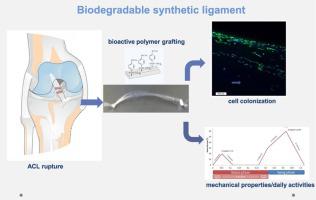IRBM ( IF 5.6 ) Pub Date : 2020-10-12 , DOI: 10.1016/j.irbm.2020.10.002 A. Rangel 1 , L. Colaço 2 , N.T. Nguyen 1 , J.-F. Grosset 2 , C. Egles 2 , V. Migonney 1

|
Background and objective
Over the past decades, anterior cruciate ligament injuries have become a considerable public health issue. Due to specific physiological conditions such injuries often demand replacement surgery and can take up to two years to a complete recovery. Using biomaterials able to accelerate the healing process could represent a remarkable progress in the field. The main goal of this article is, therein, to evaluate the mechanical properties of poly(ε-caprolactone) (PCL) fibers with biological properties enhanced by poly(sodium styrene sulfonate) (PNaSS) grafting when subjected to mechanical stress in different conditions.
Materials and methods
PCL fibers were thermal grafted with PNaSS. The grafting density was estimated by the toluidine blue colorimetric assay (TB). The influence of the grafting on in vitro primary ACL fibroblast behavior was evaluated by cell proliferation and fluorescence microscope images. The mechanical behavior was evaluated by tensile experiments in air and water, fatigue experiments and simulated walk efforts.
Results
The results show that poly(ε-caprolactone) bundles have their mechanical behavior changed by the different surface treatments and nature of mechanical stress. Although, compared with the values of the natural ligament, the poly(ε-caprolactone) has shown superior mechanical properties (Young's Modulus, elastic deformation and ultimate tensile stress) in all studied scenarios. In addition, the pNaSS-grafted surfaces presented a positive influence in the cell proliferation and morphology.
Conclusion
The pNaSS-grafted PCL has responded mechanical and biological requests for suitable ligament prosthesis material and could be considered as a promising alternative for ACL reconstruction.
中文翻译:

使可生物降解聚合物的机械特性适应前交叉韧带功能的生理学方法
背景和目标
在过去的几十年中,前交叉韧带损伤已成为一个重要的公共卫生问题。由于特定的生理条件,此类损伤通常需要进行置换手术,并且可能需要长达两年的时间才能完全康复。使用能够加速愈合过程的生物材料可能代表该领域的显着进步。本文的主要目的是评估聚(ε-己内酯)(PCL)纤维在不同条件下受到机械应力时的机械性能,该纤维通过聚(苯乙烯磺酸钠)(PNaSS)接枝增强了生物性能。
材料和方法
用 PNaSS 热接枝 PCL 纤维。通过甲苯胺蓝比色法(TB)估计接枝密度。通过细胞增殖和荧光显微镜图像评估移植对体外原代 ACL 成纤维细胞行为的影响。通过空气和水中的拉伸实验、疲劳实验和模拟步行努力来评估机械性能。
结果
结果表明,聚(ε-己内酯)束的力学行为因表面处理的不同和机械应力的性质而改变。尽管与天然韧带的值相比,聚(ε-己内酯)在所有研究情况下都显示出优异的机械性能(杨氏模量、弹性变形和极限拉伸应力)。此外,pNaSS 接枝表面对细胞增殖和形态有积极影响。
结论
pNaSS 移植的 PCL 已响应了对合适韧带假体材料的机械和生物学要求,可被视为 ACL 重建的有希望的替代方案。











































 京公网安备 11010802027423号
京公网安备 11010802027423号